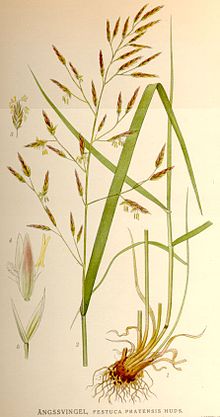Lolium pratense
| Meadow fescue | |
|---|---|

| |
| Scientific classification | |
| Kingdom: | |
| (unranked): | |
| (unranked): | |
| (unranked): | |
| Order: | |
| Family: | |
| Genus: | |
| Species: | F. pratensis
|
| Binomial name | |
| Festuca pratensis | |
| Synonyms | |
Festuca pratensis, the meadow fescue,[1] is a perennial species of grass, which is often used as an ornamental grass in gardens, and is also an important forage crop.
It grows in meadows, roadsides, old pastures, and riversides on moist, rich soils, especially on loamy and heavy soils.
It is a tall, tufted grass similar to the tall fescue, Festuca arundinacea. Tall fescue differs by having minute hairs on the auricles. It can hybridise with Lolium perenne and Lolium multiflorum.[2]
Description
It is a perennial bunchgrass, (i.e. grows in tufts), which grows 30–120 cm (12–47 in), flowering from June until August. The panicles are green to purplish. The spikelets have 5 to 14 flowers.
It has a short, blunt ligule compared to other grasses 1 mm high. The leaves are bright green and up to 4 mm across.[3]
Photos
-
Festuca pratensis
-
The base of the leaf
-
Festuca pratensis
-
Festuca pratensis
References
- Pink, A. (2004). Gardening for the Million. Project Gutenberg Literary Archive Foundation.
- ^ "BSBI List 2007". Botanical Society of Britain and Ireland. Archived from the original (xls) on 2015-01-25. Retrieved 2014-10-17.
{{cite web}}: Unknown parameter|deadurl=ignored (|url-status=suggested) (help) - ^ Collins Pocket Gude Grasses, Sedges, Rushes & Ferns Of Britain and Northern Europe, 1995, 0 00 219136 9
- ^ Grasses by C E Hubbard, 1978, published by Penguin books




